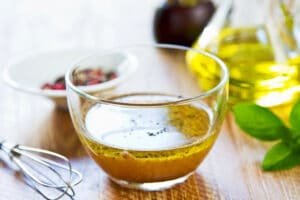Salad dressings are crucial to any salad, adding flavor and moisture to the greens and other ingredients. Countless store-bought dressing options are available but can be expensive and often contain unhealthy ingredients. Making your own dressing at home is easy and affordable, and it allows you to control the ingredients, including adding an emulsifier like egg yolk for creaminess.
There are three basic salad dressings: vinaigrette, creamy, and cooked. Vinaigrettes are the most common oil-based salad dressing made with vinegar or another acidic ingredient such as lemon juice. Creamy dressings are made with a base of mayonnaise, sour cream, or yogurt and are often flavored with herbs and spices. Cooked dressings are made by heating ingredients such as bacon, eggs, or cheese and then combining them with oil and vinegar. Each dressing type has its unique flavor and texture, making it important to choose the right dressing for your salad.

exploring the 3 basic salad dressings
3 Delicious Oil-Free Salad Dressings You NEED to Try! (Vegan & Easy)
Vinaigrettes are the most common type of salad dressing. They are made by mixing oil and vinegar or citrus juice and may include other ingredients such as herbs, mustard, or honey. The oil and vinegar are typically mixed in a ratio of three parts oil to one part vinegar, but this can vary depending on personal preference.
Vinaigrettes are well suited to green salads and are particularly good with salads that include bitter greens such as arugula or endive. They can also be used as a marinade for meat or vegetables.
The basic ingredients for vinaigrette are oil and vinegar, but there are many variations that include additional ingredients such as mustard, honey, garlic, and herbs. Here are the basic ingredients for a simple vinaigrette:
In a small bowl or jar, combine the vinegar, Dijon mustard, and honey or maple syrup (if using).
Slowly whisk in the olive oil to emulsify the mixture. If using a jar, you can shake vigorously until everything is well combined.
Season to taste with salt and pepper. Add chopped herbs if desired.
Drizzle over salads or use as a dip for vegetables to make a salad that is both refreshing and flavorful. Enjoy!
Vinaigrette is a versatile dressing that can be customized to suit your taste. Here are some variations to try:
Overall, vinaigrette is a simple and flavorful dressing that can be used on a variety of salads. With a few basic ingredients and some creativity, you can create a delicious dressing that will elevate any salad, making it one of your favorite salad dressings.
Creamy dressings are made by combining oil, vinegar or lemon juice, and a creamy ingredient such as mayonnaise, sour cream, or yogurt. Other ingredients such as garlic, herbs, or cheese can be added for flavor.
Creamy dressings, often enriched with egg yolk, are thicker and richer than vinaigrettes and are well suited to salads that include heartier ingredients such as chicken, bacon, or hard-boiled eggs. They are also good with salads that include fruit or sweet vegetables such as beets or carrots.
The ingredients for creamy dressings can vary widely, but most recipes call for a base of mayonnaise, sour cream, yogurt, or buttermilk. Other common ingredients include garlic, onion, lemon juice, vinegar, mustard, and various herbs and spices. Some recipes may also call for added sweetness, such as honey or sugar, to balance out the tanginess of the dressing.
In a medium-sized bowl, combine the mayonnaise, sour cream, and buttermilk, mixing until smooth.
Add the dried dill, parsley, garlic powder, and onion powder. Mix until all the ingredients are thoroughly incorporated.
Season with salt and pepper to taste. Adjust the consistency by adding more buttermilk if needed.
Store in the refrigerator for at least 30 minutes to allow the flavors to meld together.
Use as a dressing for salads or as a dip for vegetables and snacks. Enjoy!
There are countless variations of creamy dressings, each with their own unique flavor profile. Some popular variations include Italian dressing and other favorite salad dressings that add zest and color to the greens.
Overall, creamy dressings are a delicious and indulgent addition to any salad or vegetable dish, and paprika can be added for a hint of spice. With so many variations to choose from, there is sure to be a creamy dressing that will suit any taste, and dressing may be customized with spices like paprika.
Fruit-based dressings are made by blending fresh or frozen fruit with oil, vinegar, or citrus juice. Other ingredients such as honey, mustard, or herbs can be added for flavor.
Fruit-based dressings are sweet and tangy and are well suited to salads that include fruit or sweet vegetables such as berries, peaches, or tomatoes. They are also good with salads that include bitter greens such as arugula or endive.
In conclusion, understanding the basic types of salad dressings can help you choose the right dressing for your salad. Whether you prefer a tangy vinaigrette, a rich and creamy dressing, or a sweet and fruity dressing, there is a dressing that will complement your salad perfectly.
The ingredients for fruit-based dressings can vary depending on the recipe, but most of them include a combination of fruit, vinegar, oil, and sweetener. Some common fruits used in these dressings are berries, citrus fruits, and tropical fruits like mango and pineapple. Vinegar can be any type of vinegar, but apple cider vinegar is a popular choice. Oil can be any type of oil, but olive oil is a common choice. Sweeteners can be honey, maple syrup, agave nectar, or sugar.
There are many variations of fruit-based dressings, and you can customize them to your liking. Here are a few ideas:
Fruit-based dressings are a delicious and healthy way to add flavor to your salads. They are easy to make and can be customized to your liking. Try experimenting with different fruits and flavors to find your favorite combination.